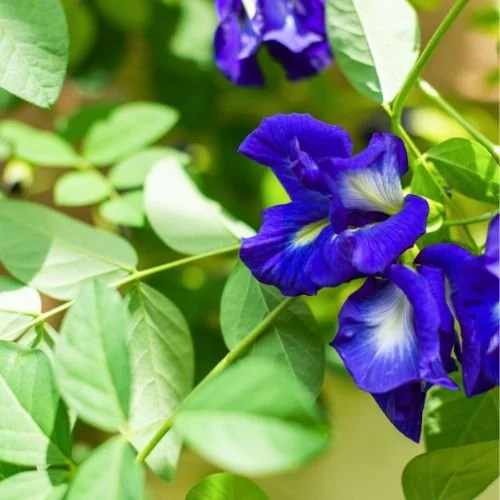

Organic Butterfly pea flower seeds
Butterfly Pea Flower (Clitoria ternatea)
A captivating perennial vine renowned for its striking blue flowers and diverse benefits for both garden and well-being.
Ecological Benefits:
Nitrogen Fixer: As a legume, butterfly pea forms a symbiotic relationship with soil bacteria to fix atmospheric nitrogen, enriching the soil and reducing the need for synthetic fertilizers.
Pollinator Attraction: Its vibrant blooms attract a variety of pollinators, including bees and butterflies, contributing to garden biodiversity and fruit/vegetable production.
Soil Improvement: Its vigorous growth and nitrogen-fixing abilities contribute to improved soil health and fertility, especially in degraded soils.
Ground Cover/Trellis Plant: Its twining habit makes it an excellent choice for covering trellises, fences, arbors, or as a lush groundcover.
Health Benefits:
Antioxidant Powerhouse: Rich in anthocyanins, the compounds responsible for its vivid blue color, butterfly pea possesses strong antioxidant properties that help combat free radicals and support overall cellular health.
Cognitive Support: Traditionally used in Ayurvedic medicine, it's believed to enhance memory, focus, and cognitive function.
Anti-inflammatory: Contains compounds with anti-inflammatory properties, potentially aiding in reducing inflammation throughout the body.
Stress Relief: Some traditional uses suggest it has calming properties that may help alleviate stress and promote relaxation.
Skin and Hair Health: Its antioxidant content is thought to contribute to improved skin radiance and hair health.
Natural Food Coloring: The flowers are widely used to create natural blue food and drink dyes, which famously change color to purple or pink when an acidic ingredient (like lemon juice) is added.
Cultivation:
Sowing: Can be sown directly outdoors after the last frost or started indoors 6-8 weeks prior in cooler climates.
Method: Plant seeds about 6-8 inches apart.
Location: Prefers full sun (at least 6-8 hours daily) and well-draining soil. Can tolerate a range of soil types.
Watering: Water regularly, keeping the soil consistently moist but not soggy. Once established, it can tolerate some drought.
Support: As a climbing vine, it requires a trellis, fence, or other support structure to climb and spread.
Hardiness: A tropical perennial, it thrives in USDA Zones 9-11. In cooler climates, it's often grown as an annual or overwintered indoors in containers.
Blooming: Produces an abundance of beautiful blue flowers throughout the warm months. Regular deadheading of spent flowers encourages more blooms.
Butterfly Pea Flower (Clitoria ternatea)
A captivating perennial vine renowned for its striking blue flowers and diverse benefits for both garden and well-being.
Ecological Benefits:
Nitrogen Fixer: As a legume, butterfly pea forms a symbiotic relationship with soil bacteria to fix atmospheric nitrogen, enriching the soil and reducing the need for synthetic fertilizers.
Pollinator Attraction: Its vibrant blooms attract a variety of pollinators, including bees and butterflies, contributing to garden biodiversity and fruit/vegetable production.
Soil Improvement: Its vigorous growth and nitrogen-fixing abilities contribute to improved soil health and fertility, especially in degraded soils.
Ground Cover/Trellis Plant: Its twining habit makes it an excellent choice for covering trellises, fences, arbors, or as a lush groundcover.
Health Benefits:
Antioxidant Powerhouse: Rich in anthocyanins, the compounds responsible for its vivid blue color, butterfly pea possesses strong antioxidant properties that help combat free radicals and support overall cellular health.
Cognitive Support: Traditionally used in Ayurvedic medicine, it's believed to enhance memory, focus, and cognitive function.
Anti-inflammatory: Contains compounds with anti-inflammatory properties, potentially aiding in reducing inflammation throughout the body.
Stress Relief: Some traditional uses suggest it has calming properties that may help alleviate stress and promote relaxation.
Skin and Hair Health: Its antioxidant content is thought to contribute to improved skin radiance and hair health.
Natural Food Coloring: The flowers are widely used to create natural blue food and drink dyes, which famously change color to purple or pink when an acidic ingredient (like lemon juice) is added.
Cultivation:
Sowing: Can be sown directly outdoors after the last frost or started indoors 6-8 weeks prior in cooler climates.
Method: Plant seeds about 6-8 inches apart.
Location: Prefers full sun (at least 6-8 hours daily) and well-draining soil. Can tolerate a range of soil types.
Watering: Water regularly, keeping the soil consistently moist but not soggy. Once established, it can tolerate some drought.
Support: As a climbing vine, it requires a trellis, fence, or other support structure to climb and spread.
Hardiness: A tropical perennial, it thrives in USDA Zones 9-11. In cooler climates, it's often grown as an annual or overwintered indoors in containers.
Blooming: Produces an abundance of beautiful blue flowers throughout the warm months. Regular deadheading of spent flowers encourages more blooms.